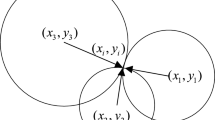Abstract
Currently most of the existing indoor fingerprint positioning algorithms are based on fingerprint database. The accuracy of the fingerprint database will directly affect the final positioning accuracy. Therefore, through the research of fingerprint data, a method based on skewness-kurtosis normality test and Kalman filter fusion is proposed. In the training phase, the RSSI (Received Signal Strength Indication) samples received on each fingerprint point are tested based on the skewness-kurtosis normality. If the normal distribution model is met, the normal distribution function is used to estimate the probability density of the samples. If not the kernel function will be used. And then the value of the large probability density is taken for Kalman filtering, and finally, the averaged value after filtering is used to establish a high-precision fingerprint database. In the online positioning stage, the weighted KNN (K-Nearest Neighbor) is used to estimate the position, and finally, the positioning point is corrected by the fusion of the Levenberg-Marquardt method and the Kalman filter. The optimization of the three stages can improve the positioning accuracy. The simulation results show that the indoor positioning method proposed in this paper has the least number of iterations and the positioning accuracy is improved by 60% compared with the traditional Kalman filtering method.








Similar content being viewed by others
References
Han G, Xu H, Duong TQ et al (2013) Localization algorithms of wireless sensor networks: a survey [J]. Telecommun Syst 52(4):2419–2436
Wu S, Rendall J, Smith M, Zhu S, Xu J, Yang Q, Wang H. Survey on prediction algorithms in smart homes, IEEE Internet Things J
Liu Y, Chen Q, Liu G, Liu H, Yang Q EcoSense: a hardware approach to on-demand sensing in internet of things, IEEE Communications Magazines
Chen S, Qiao X, Mao J et al (2015) Indoor secondary positioning method based on received signal strength [J]. Journal of Sensing Technology 28(04):572–577
Fang S, Lin T (2010) A dynamic system approach for radio location fingerprinting in wireless local area networks [J]. IEEE Trans Commun 58(4):1020–1025
Pei L, Liu J, Chen Y et al (2017) Evaluation of fingerprinting-based WiFi indoor localization coexisted with Bluetooth [J]. The Journal of Global Positioning Systems 15(1):3
Chen X, Chen X, Zou S (2017) Indoor location algorithm based on normality test [J] 38(03):41–45
Mei C, Fan J (2006) Data analysis method [M]. Beijing:Higher education press
H K P, B V. (2007) Nonparametric Statistics with Applications toScirnce and Engineering [M]
Wang Y, Wen L, Chen M (2010) Mathematical dictionary [M]. Science Press
Q L Y, W Z L, Q W, et al. (2010) Nonparametric Statistics Methods [M]. Chendu:Southwest Jiaotong University Press
Huang Y, Qi B, Chen S (2013) Modification of advanced boundary discriminative noise detection algorithm; proceedings of the 2013 10th IEEE international conference on control and automation (ICCA), F 12-14 June 2013
S J, K U J. (2004) Unscented filtering and honlinear estimation [J]. 92(3):401–422
CHUN L, YING M (2016) Research on improved Kalman filter in Beidou pseudo ranges positioning [J]. Journal of Electronic Measurement and Instrumentation 30(05):779–785
H W, W W. (2006) Study on improved Kalman filtering algorithm [J]. Ship Engineering, 28(4):34–38
Barsocchi P, Crivello A, La Rosa D, Palumbo F (2016) A multisource and multivariate dataset for indoor localization methods based on WLAN and geo-magnetic field fingerprinting, 2016 International Conference on Indoor Positioning and Indoor Navigation (IPIN), Alcala de Henares, pp. 1–8. doi: https://doi.org/10.1109/IPIN.2016.7743678
Chu C, Yang S A particle filter based reference fingerprinting map recalibration method, in IEEE Access. doi: https://doi.org/10.1109/ACCESS.2019.2931992
Dongjin W, Linyuan X, Jijun G, Qingyi P (2018) Robust adaptive extended Kalman filtering for smart phone-based pedestrian dead reckoning systems, 2018 Ubiquitous Positioning, Indoor Navigation and Location-Based Services (UPINLBS), Wuhan, pp. 1-8. doi: https://doi.org/10.1109/UPINLBS.2018.8559880
Acknowledgments
The authors would like to thank National Natural Science Foundation of China (No. 61671482, 61902431, 61872385 and 61601519), and the Key Research and Development Program of Shandong Province (Public Welfare Category) with No. 2019GGX101048 for support. Also, the authors would express the gratitude to Fundamental Research Funds for the Central Universities (No. 17CX02042A, 19CX05003A-9 and 18CX02136A) in this work.
Author information
Authors and Affiliations
Corresponding authors
Additional information
Publisher’s note
Springer Nature remains neutral with regard to jurisdictional claims in published maps and institutional affiliations.
Rights and permissions
About this article
Cite this article
Cui, X., Wang, M., Li, J. et al. Indoor Wi-Fi Positioning Algorithm Based on Location Fingerprint. Mobile Netw Appl 26, 146–155 (2021). https://doi.org/10.1007/s11036-020-01686-1
Accepted:
Published:
Issue Date:
DOI: https://doi.org/10.1007/s11036-020-01686-1




